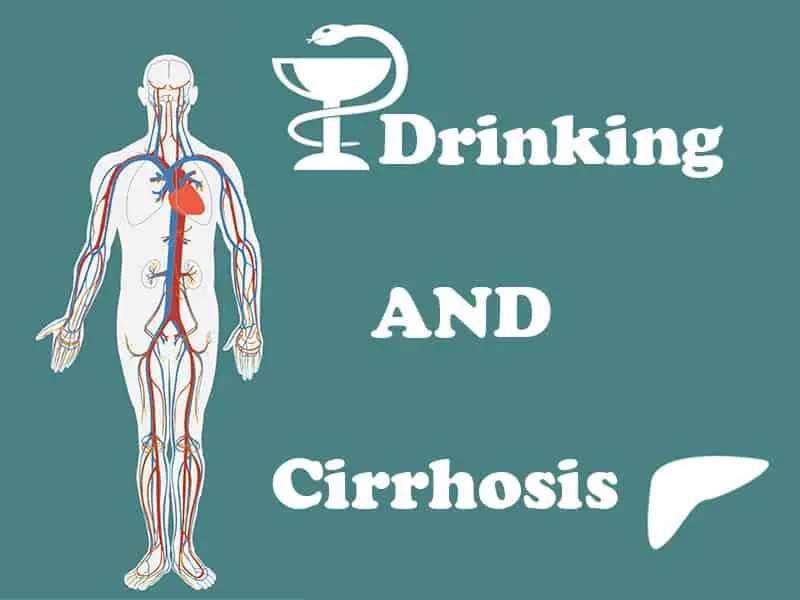How Much Drinking Leads To Cirrhosis?: Maybe you read about it on the internet or maybe your friend came down with it; and you wonder to yourself, why is that Jack and I drink the same every week yet he got cirrhosis while I’m perfectly fine? Does he have a secret drinking buddy?
Do you tolerate it better? And for that instance, what does tolerance even mean?

Inspiring your journey, one story at a time. #LifeFalcon.
This article runs you through how much alcohol you have to drink to get cirrhosis, some general guidelines on drinking, what other conditions can excess alcohol intake lead to, and how you can drink and stay healthy at the same time.
Table of Content
Analysis of Alcohol and Liver Cirrhosis:

Truth be told, there is no straight answer to how much alcohol you have to drink to get cirrhosis; largely because every individual’s body is built differently and functions differently. Our lifestyles, daily routines, eating habits, and even down to what’s in our DNA all affect our metabolic rate.
The term metabolism, simply put, reflects all the chemical reactions in our body and the metabolic rate refers to the rate at which they are being carried out. Some common examples would be the buildup of protein, digestion of the food we eat to provide us with energy, and many more.
Break down of alcohol is another such example of a metabolic reaction in our body and so naturally, any factor that affects the general metabolic rate of the body also affects how alcohol gets broken down.
The main implication it has is that each individual breaks down alcohol in a different way and so in a situation where your friend can get away with drinking 2 cans of beer daily and get away with it, you might drink 1 can a day and be at a much higher risk for getting alcohol-related diseases or liver cirrhosis.
Hence, these variables can change the amount of alcohol you have to drink before you get cirrhosis.
The factors that merit special consideration when answering this question include the pattern of drinking, the duration of drinking, the type of beverage consumed, the gender, the lifestyle of the drinker, and the physical profile.
Here’s an in-depth breakdown of how these factors come into play.
Gender

Generally, men have a faster metabolic rate than women. What this translates into in the context of alcohol intake is that for equal amounts of alcohol consumed, the alcohol molecule is more likely to persist in the body of women as it is for men. A slower break down leads to a greater accumulation of Acetaldehyde; the main toxic by product of alcohol that has been implicated in the pathogenesis of liver cirrhosis and also hepatocellular carcinoma.
Taking this into consideration, the usual set point beyond which there is a substantial increase in the risk for cirrhosis is set at 3 ounces of alcohol a day. This is the equivalent of drinking about 3 cans of beer, 3 glasses of wine or 3 shots of hard liquor.
For women the set point is much lower. According to clinical data, even the consumption of half this amount (1½) is associated with an increased risk of getting cirrhosis.
Though the set value is not something to aim for and if you do drink, drink responsibly.
Pattern of drinking
According to new research, it is not just how much you drink but how you drink that plays a significant role in causing alcohol related diseases.
One particular pattern that you need to consider is binge drinking.
Described as the intake of a large amount of alcohol in a short period of time, binge drinking puts a greater load on the body, particularly the liver, than if you drank the same amount over a longer period of time.
The acute influx of byproducts of alcohol metabolism, such as Acetaldehyde and Acetate, overburden the enzymatic machinery of the liver leading to their accumulation and associated toxic effects. In this case, even short amounts of alcohol taken in as part of binge drinking can lead to cirrhosis.
Type of beverage

This is another variable that needs consideration. Take the example of two drinking buddies Mark and Bill, both in their 30s, lean men with an active lifestyle. Mark is an avid drinker of beers while Bill prefers hard liquor. Both of them meet up every weekend at a local bar and drink 2 glasses of their preferred beverage.
Do you think both of them have the same risk of developing alcohol related medical conditions?
The answer to that would be no; the actual percentage of alcohol in these two beverages differs which leads to both Mark and Bill having different risk of alcohol associated complications.
To break it down, most beers contain 2% to 7% alcohol, most wines contain 10% to 15% and most hard liquors contain 40% to 45% of alcohol. Though most bars take this into account and change the quantity of the beverage relative to the percentage of alcohol it contains, the fact merits discussion since many avid drinkers are likely to drink these at home or parties.
In this context, Bill would be more likely to develop cirrhosis!
Genetic polymorphisms
Consider the same example of Mark and Bill, give them the same drink in the same amount; both of them would still be at different risks of developing cirrhosis. The explanation of this comes down to a phenomenon with a rather cumbersome name that geneticists call genetic polymorphisms.
The term simply means that due to the different genetic makeup of each individual, the constitutive or baseline activity of proteins in their body may vary. The proteins, in this context, would be enzymes and particularly hepatic enzymes. With differing activities of hepatic enzymes come differing rates of alcohol metabolism and differing accumulation of toxic byproducts.
These genetic polymorphisms are the main determinants of what you might know as your tolerance to alcohol.
Duration of drinking
As you might expect, the longer you drink, the greater your chance of developing cirrhosis.
Through the long-term intake of alcohol, the liver undergoes damage that gradually keeps on accumulating with the end result being the completely fibrosed and scarred liver we know as cirrhosis.
In particular, consumption of alcohol for over 10 or more years substantially increases your risk of developing cirrhosis.
Physical profile

Obesity comes with its own sets of physical and mental health problems; one of them being liver cirrhosis. Research has consistently proven that for an obese person the risk is significantly higher than for someone with a leaner physical profile. One such research showed that Cirrhosis-related deaths or hospitalizations were more common in obese persons (0.81/1000 person-years) as compared to people with normal weight (0.45/1000 person-years).
What this means for you is that if you know someone who falls in the overweight category, ask them to dial down on the alcoholic drinks.
Presence of other liver conditions
Since your liver plays the central role in the metabolism of alcohol, having other existing diseases that compromise the liver functions could mean that the damage alcohol and its byproducts exert on the liver hits harder than it would normally.
These conditions can include viral hepatitis, being malnourished or being on medications that are known to be hepatotoxic.
General guidelines on alcohol consumption

The general recommendation on alcohol is to drink moderately, but with the different ways our bodies react to it make the term ‘moderately’ different for each individual.
Simply put, if you avidly consume alcohol on most weeks, to keep the health risks to a minimum; both men and women are advised to not drink more than 14 units a week on a regular basis.
If you do consume as much as 14 units a week on a regular basis, then the recommendation is to spread your drinking over 3 or more days.
If you intend to cut down on your drinking habit, try to have several days each week where you drink no alcoholic beverage at all.
Note: Fourteen units is equivalent to 6 pints of average-strength beer or 10 small glasses of low-strength wine.
The guidelines also state that the following people should not partake in alcohol at all:
- Women who are or might be pregnant
- Persons under the legal age for drinking
- People with pre-existing medical conditions that are likely to aggravate the ill-effects of alcohol
- People using medications that can interact with alcohol
- Persons who are under alcohol rehabilitation therapy or those who cannot control the amount of alcohol they drink.
Apart from getting cirrhosis, failure to comply with these guidelines can lead to many other health conditions as described in the section below.
Other alcohol-related disorders
The desire to drink while staying healthy is difficult to implement, which is why this beverage is such a common addiction. If unchecked, alcohol consumption can lead to the following conditions:
- Alcoholic cardiomyopathy
- Alcoholic myopathy
- Alcoholic gastritis
- Alcoholic polyneuritis
- Alcohol-induced pancreatitis
- Fetal alcohol syndrome in babies born to women who frequently imbibe during pregnancy
Your risk of developing these disorders can be cut down to a minimum by following the recommended guidelines stated above. The following paragraph contains some useful tips on how to further reduce alcohol related side effects, while drinking in moderation.
How to cut down on the harmful effects of alcohol?
Though the complete elimination of alcohol related side-effects only comes with complete abstinence, there are some ways by which they can be cut down or minimized. These include:
Eating before you imbibe
Drinking on an empty stomach can potentially aggravate alcohol related adverse effects and so the obvious way to combat this is to eat health, wholesome meals before you imbibe.
Similarly, you should also consider what you eat. Focus on healthy fats and lean sources of protein; these will help to slow digestion and the absorption of alcohol. Avoid foods that contain refined carbohydrates, like cookies, chips, and rice as they are absorbed quickly and won’t slow the effects of alcohol.
Using a detox remedy
The use of a natural homeopathic detox remedy such as Party Detox may help protect your stomach and support liver function. Such remedies can be used before, during or after the drinking session.
Staying hydrated
If you drink water adequately both before and after your drinking session, it not only helps your body combat any hangover state and dehydration, but it can also help lower the actual quantity of alcohol you drink.
Use honey
Though this is not backed by authentic research, anecdotal evidence does exist that says that honey helps to reduce the effects of a hangover by metabolizing alcohol more quickly. You might even find its sweet taste to your liking!
Note that even with all these methods, the risk of developing alcohol-related medical conditions doesn’t fade and so the expert advice would be to drink little and only in moderation.
Summary
There is no fixed volume of alcohol that you need to drink before you can get cirrhosis. Extensive research has shown us that factors like gender, tolerance and physical profile of the drinker along with quantity and type of beverage consumed all play a role.
In the light of this information, your best bet to safeguard yourself against cirrhosis and other alcohol-related medical conditions would be to stay well clear of the upper limit of the recommended intake.
Avoid regularly consuming up to 3 ounces of alcohol if you’re a male and half that amount if you’re a female. Regularly hydrate yourself both before and after drinking and avoid social gatherings where people partake in heavy drinking.
If you follow these recommendations, cirrhosis would be a far-fetched reality for you and I’m sure your body will appreciate it!



















